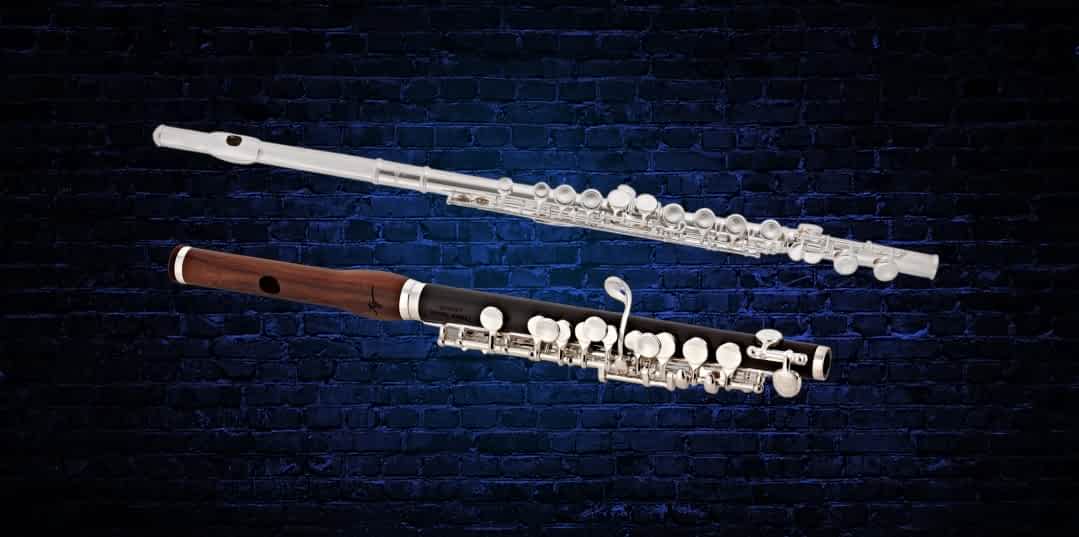Thinking about playing the flute or the piccolo? Each of these lovely woodwind instruments can make magical melodies, but which one is right for you?
The flute and piccolo are two popular musical instruments that belong to the woodwind family. While they may look similar and produce similar sounds, there are some notable differences between them.
Many wondered, “How do flute and piccolo players produce sound?”.
For starters, the main difference between piccolo vs flute lies in their size and pitch range. The piccolo is smaller and plays one octave higher than the flute. While both instruments are members of the woodwind family and played with similar techniques, the piccolo is known for its shrill and piercing sound, while the flute produces a smoother and mellower tone.
Whether you are a beginner musician or an experienced player, understanding the differences between the flute and piccolo can help you make an informed decision when choosing your perfect match. This article will explore the differences between the two instruments, including their history, size, materials, and playing techniques.
So, let’s dive into the world of flute and piccolo and explore the nuances of each instrument!
The Flute and Its History
The flute is one of the oldest musical instruments in the world, dating back to prehistoric times. The earliest flutes were made from bones, such as the femur of a large animal, and were used for hunting and religious rituals.
The modern flute, as we know it today, was developed in the 19th century. It’s a member of the woodwind family and is made of metal or wood. The flute is played by blowing air across a small opening at the top of the instrument, causing the air to vibrate and produce sound.
The flute has been used in many musical genres, from classical to jazz to folk music. It’s known for its clear, sweet sound and ability to play low and high notes. Famous flautists include James Galway, Jean-Pierre Rampal, and Ian Anderson of the band Jethro Tull.

Overall, the flute has a rich history and continues to be an important instrument in the world of music.

COMES WITH: Cleaning swab, Cloth, Gloves, and ABS case
FEATURES: Closed-hole flute - easier for beginner
Stagg FL111 Flute
When you check the price above, you’ll see there are loads of great places to buy this item. Our personal favorite is Gear4music.
It is the largest music retailer in the UK and fast becoming the most respected online music shop in the US too. Their customer service is excellent, they have competitive prices, really fast shipping, and usually have the longest guarantee.
Most professional musicians use Gear4music, so there is no reason why you shouldn’t too!
- Offset G for extra ergonomic design
- Split E for easier production of higher notes
- Best for practicing only
The professional musician who wrote this article combined many things,
from the product build, manufacturer’s reputation through to feedback
from other users, to create our famous TedScore™.
The Stagg FL111 is a high-quality flute designed for both beginners and intermediate players.
It features a silver-plated body and headjoint, providing a bright and clear tone. The flute also includes closed hole keys, making it easier for beginners to learn and play.
When you compare it to other flutes out there, this really shines because it gives you top-notch quality without burning a hole in your pocket. It’s like getting the best of both worlds – great performance at a price that won’t make you wince.
When I play this flute, it feels really smooth and responsive, and the tone is clear and bright.
It might not have all the fancy advanced features, but trust me, the Stagg FL111 is still worth buying because it’s built to last and has a great sound.
So, if you’re after a dependable flute that won’t break the bank, this one’s definitely worth checking out.
The Piccolo and Its History
The piccolo is a member of the woodwind family and is essentially a smaller version of the flute. It’s pitched a higher octave than the flute and is known for its bright and piercing sound.
The Piccolo was first developed in the early 18th century and was made of wood. Over time, metal became the preferred material for piccolos, and today, most piccolos are made of silver or a silver alloy. Most piccolos have a conical body with a cylindrical head, like the Baroque flute.
Pyotr Ilyich Tchaikovsky was one of the most famous composers to write for the piccolo. He featured the instrument prominently in his ballets, including “The Nutcracker” and “Swan Lake”, as you can see in this video:

Today, the piccolo is a popular instrument in orchestras, concerts and marching bands and is often featured in solos and as part of ensembles.

COMES WITH: maintenance-free ABS resin body
FEATURES: A split-E mechanism to make your high E notes clearer
Yamaha YPC32 Piccolo
When you check the price above, you’ll see there are loads of great places to buy this item. Our personal favorite is Gear4music.
It is the largest music retailer in the UK and fast becoming the most respected online music shop in the US too. Their customer service is excellent, they have competitive prices, really fast shipping, and usually have the longest guarantee.
Most professional musicians use Gear4music, so there is no reason why you shouldn’t too!
- Silver plated headjoint
- ABS resin body
- A great value Pirc
- Easy to play
- Pretty much indestructible!
- Great for flautists looking to explore the world of piccolo and develop a solid technique.
- Can sound a little ‘plasticy’
- Low register is not as resonant as a wooden model.
The professional musician who wrote this article combined many things,
from the product build, manufacturer’s reputation through to feedback
from other users, to create our famous TedScore™.
The Difference Between Flute and Piccolos
When it comes to other woodwind instruments though, the flute and piccolo are often compared and contrasted. While they may look similar, some distinct characteristics set them apart. So, what is the difference between a flute and a piccolo?
Let’s learn more about them.
Materials Used
The materials used in the instrument’s construction can affect the instrument’s sound quality and durability.
The flute is typically made of metal or wood, silver-plated brass, nickel silver, silver, or gold. Professional flutes are often made of solid silver, which produces a warm, rich tone. On the other hand, wooden flutes are often used in folk music and produce a more mellow sound.
Conversely, many metal piccolos are made of silver or nickel. This is because the piccolo is a smaller instrument and needs to withstand the pressure of the player’s breath without cracking or bending. But there are also wooden piccolos, which have a sweeter sound and more dynamic flexibility.
Comparing the Size
The difference in size can affect the amount of air needed to produce sound and the finger placement required to play each instrument. Flutes are generally larger than piccolos, with a standard concert flute around 26 inches long. At the same time, a piccolo looks like a miniature flute, approximately half the size at 13 inches in length.
Additionally, flutes are assembled from three separate pieces: the head joint, body, and foot joint, while piccolos are usually made in one piece.
Sounding Range & Pitch
The flute has a lower pitch than the piccolo and has a range of approximately three octaves. Conversely, the range of piccolo is approximately two octaves and produces a higher pitch because of its smaller size, making it a transposing instrument. A piccolo plays one octave higher than the flute, producing bright and piercing tones that stand out in musical compositions.
Embouchure and Ergonomics
The embouchure, or how the player’s lips and mouth interact with the instrument, differs for flutes and piccolos. The flute embouchure is typically more relaxed, while a piccolo player’ embouchure requires tightness to produce higher notes.
The ergonomics of the two instruments are also different. Flutes are held horizontally, with the player’s hands and fingers covering the tone holes. Piccolos are held vertically, with the player’s fingers covering the keys.
The basic fingerings for the two instruments are similar, but the piccolo fingerings require greater strength and force, which could present more of a challenge for a young musician.
Flute or Piccolo: What Should You Play?
Will you be playing in an orchestra?
The flute and piccolo are great options for playing in an orchestra or a marching band. However, the piccolo is more of a solo piccolo instrument and adds a unique sound to the music. If you enjoy being in the spotlight, the piccolo might be your better choice.
On the other hand, the flute is a more versatile instrument and is used in a wider range of music genres. It’s also a great option if you prefer to blend in with the rest of the ensemble.
The Flute is Easier than Piccolo
According to some experts, the flute is generally considered easier to play than the piccolo. The flute requires less physical strength and force, making it a good choice for younger or beginner musicians. Conversely, the piccolo requires greater strength and precision, which can be challenging for some piccolo players.
However, it’s important to note that every musician is different, and what may be easy for one person may be difficult for another. It’s always a good idea to try both instruments and see which one feels more comfortable and natural to you.
Piccolo vs flute
Summary
So, after weighing the pros and cons of playing the flute and the piccolo, which instrument should you choose? Ultimately, it comes down to personal preference and what you want from playing the instrument.
If you’re looking for versatility and the ability to play a wider range of music, the flute may be your better option. With a deeper sound and a broader range of notes, you can play various genres, from classical to jazz to pop.
On the other hand, if you want to stand out and be a soloist, the piccolo is a great option. With its high-pitched sound, you can float over the rest of the ensemble and shine through, even if you don’t have a designated solo.
Regardless of which instrument you choose, the flute and the piccolo require dedication and practice to master. But with hard work and determination, you can create beautiful music!
Which wind instrument did you choose? We’d love to know in the comments!
FAQ's
There is no clear answer to this question. It all depends on personal preference and the type of music being played. The flute is a larger instrument that produces a deeper sound and has a broader range of notes. The piccolo, on the other hand, is smaller and produces a higher, brighter sound. Both instruments are their own unique challenges and have their own strengths and weaknesses.
Yes, flute players can play the piccolo. The fingerings for the piccolo are the same as the flute, but the embouchure and air support needed to play the piccolo is different from concert flutes. It takes practice for piccolo players to adjust to the smaller size and higher pitch, but many flute players enjoy the challenge and versatility of playing both instruments.
Learning the flute before learning the piccolo is unnecessary, but it can be helpful. The fingerings for the piccolo are the very same fingerings as the flute, so having experience with it can make it easier to learn the piccolo. However, learning the piccolo without prior flute experience is possible.
The piccolo and flute are similar in that they’re played by blowing air across a mouthpiece. However, the piccolo is smaller and produces a higher sound than the flute. The fingerings for the piccolo are the same as the alternate fingerings for the flute, but the embouchure and air support needed to play the piccolo is different.
A piccolo is a small, cylindrical woodwind instrument that is about half the size of a standard flute. It has the same fingerings as a flute but produces a higher, brighter sound due to its smaller size.
A flute works by producing sound through the vibration of air blown across a small opening in the headjoint of the instrument. The player creates different notes by covering or uncovering the finger holes along the body of the instrument, which changes the length of the air column and alters the pitch of the sound produced.
To play the piccolo, hold the instrument vertically and blows air across the mouthpiece while covering or uncovering the finger holes to produce different notes. The player must use a high level of breath control and precision in their finger movements to produce a clear, bright sound.












Isn’t the flute like way easier to start with than a piccolo? I heard piccolos can be super tricky cause of their size and all. But then again, bigger ain’t always easier, right?
As someone who’s taught both instruments, I found the sections on the sounding range and pitch and also the materials used to be incredibly insightful. It’s key information for my students who are deciding which instrument to pick up next. Thank you for sharing this, Hannah. It will be a valuable resource for my classes.
piccolo sounds like a fancy drink lol does it come with an umbrella too
So I’ve been playing the flute for a bit and thinking about adding the piccolo to my practice. The part where you compare the embouchure and ergonomics really caught my interest, Hannah . How different is it to adjust from one to the other? I find the flute challenging at times, so curious if the piccolo might suit me better or be even more of a challenge.
Love both flute and piccolo! Each has its charm. Go for it!
The transition can be tricky but not insurmountable. The piccolo requires tighter embouchure and can be more taxing physically. If you’re good with high notes on the flute, it’ll help.